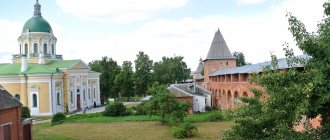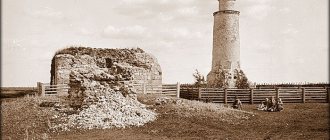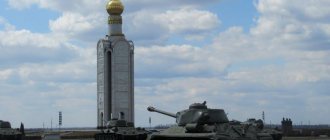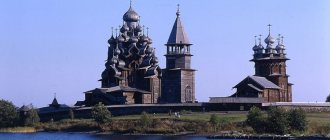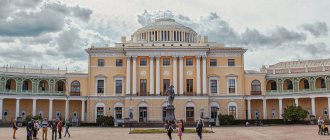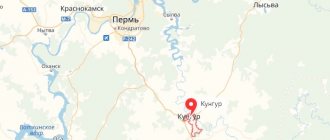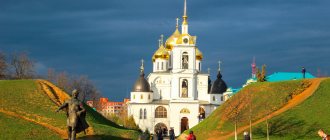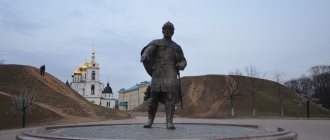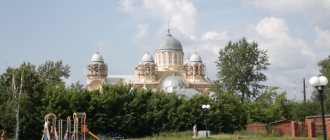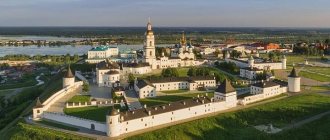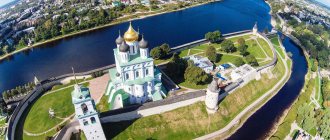The ancient city of Dmitrov is not as famous as Moscow, although it is its contemporary. It is located a little north of the capital. Its founder, Yuri Dolgoruky, founded the city back in 1154. Then it was the extreme northern outpost, which covered the road to Suzdal. Then completely wild places began, endless swamps and swamps. Almost from the very day of its formation, the city was an important strategic center, which made it possible to get to the upper Volga by water through Yakhroma, Sestra and Dubna. The route to Suzdal passed here, along the Vela River.
History of the battle fortress
A strategically important point could not do without military fortifications, which is why already in 1181 the city was a powerful fortress. The Dmitrov Kremlin, the current miracle, a living museum, the heritage of our ancestors, then had very specific functions. The earliest buildings were earthen ramparts with deep ditches. Their height was amazing, more than 15 m, and their total length was about 1000 m. A little later, walls made of powerful logs with battle towers were erected on them. The Dmitrov Kremlin grew and developed; by the 17th century, according to surviving documents, it already had 8 fortress towers.
In those days, all the buildings were wooden and burned down during the Time of Troubles. There were no stone fortifications then. The internal territory of the fortress was relatively small; there were huts of the princely squad, houses of artisans and traders. Today the Dmitrov Kremlin is being recreated, the stories of the ancient museum come to life within its walls, creating a stunning atmosphere. Despite the fact that many buildings have been reconstructed, they very accurately convey the spirit of their time. If you are traveling around the Golden Ring of Russia, be sure to visit this cozy corner.
History of the museum
The museum was opened in 1918, the initiators were the local intelligentsia and the district zemstvo. The first director was M.N. Tikhomirov, a future famous scientist and academician. He was helped in this by Pyotr Krapotkin, a famous geographer, historian and anarchist theorist. He lived his last years in Dmitrov.
The museum collection was formed in the 1920s. It was based on objects collected during ethnographic expeditions, works of art - paintings, decorative and applied arts, temple and folk art, and items from estate life. The museum fund also stores many rare documents, photographs and film materials1.
The main architectural monuments of the museum-reserve: Zemlyanoy Val of the 11th-12th centuries, the Assumption Cathedral of the 16th century, the Elizabethan Church of the late 19th century, the building of the former women's gymnasium of the early 19th century, the wooden 5-tier iconostasis of the Assumption Cathedral.
Why is the Dmitrov Kremlin so unique?
Most Russian fortresses were built on hills, this allowed them to occupy better observation positions and have a significant advantage during a siege. However, the ancient builders used a different principle when they founded the Dmitrov Kremlin. History shows that alternative solutions have often been more effective. The fortress was built in a swampy lowland, and the swamp, starting immediately behind the rampart, served as a natural defense. To this day, this historical monument is a symbol of the highest skill of its creators. We will try to take you on a virtual walk, in which we will tell you about the main attractions.
Exposition
The exhibition space of the museum begins with the Dmitrov Kremlin and its surrounding territory. It is surrounded by an earthen rampart created in the 12th-16th centuries; at the moment it is a monument of defensive architecture. The buildings that formerly housed the Public Meetings and the Treasury now house the History and Art Department, which includes two independent exhibitions.
The museum's art collections are also extensive. From the point of view of the uniqueness of the collection, this is one of the most interesting places in the Moscow region. The department occupies the Public Meetings building. Among the exhibits are church art, decorative and applied arts, Russian and Western European painting of the New Age, folk art and art of the last century.
The road to the museum
The easiest way is to use the railway services. Every day, several times a day, trains to Dmitrov leave from Odintsovo, Golitsyno, Kubinka and many other settlements. If your starting point is Moscow, then you can board these trains at Savelovsky Station, as well as at stations near the Fili and Begovaya metro stations. Since 2011, a comfortable air-conditioned bus departs from the Altufyevo metro station to Dmitrov every 30 minutes. Just an hour and a half on the road - and you are at your destination. If you have a personal car, the journey will not take you more than an hour. This is why there is Dmitrovskoye Highway. As you can see, you can easily plan your trip and visit the Dmitrov Kremlin. How to get there is up to you, but the easiest way is to drive your own car.
Chapel of Alexander Nevsky
If you were driving along the highway, the road will lead you straight to the city center, to the earthen rampart. The Dmitrov Kremlin Museum-Reserve is right in front of you, but before you start exploring it, you can visit this ancient chapel. It is located in the center of the old city, on the site of the former ancient Nikolsky Gate and earthen rampart. Until 1868 it was a wooden building, but it was completely destroyed. In its place, a stone chapel was erected, which still glorifies the holy noble prince Alexander Nevsky. The reason for the creation of this chapel was the miraculous deliverance from the death of Alexander II. There was a period in history when desolation reigned in the chapel, but in the 90s it was returned to the Orthodox Church.
Dmitrov Kremlin
Video: Dmitrov Kremlin
History of the Dmitrov Kremlin
Dmitrov Kremlin from above
As a result of archaeological research carried out at the beginning of this millennium on the territory occupied by the Dmitrov Kremlin, it became possible to look into more ancient times. It turned out that Slavic settlements existed on this land at least two centuries before the chronicle mention of the founding of the Dmitrov Kremlin. Whether these settlements were a city that defended its borders with elementary earthen embankments along the perimeter is not known for sure: archaeologists have not yet been able to find fortifications that would correspond to that time period.
Of the defensive structures of the Dmitrov Kremlin from the time of Dolgoruky, only the earthen rampart has survived to this day. Its shape resembles an irregular oval (a kind of egg), and stretches from south to north for approximately 990 m, and its height ranges from 7 to 9 meters. This corresponds to the historical buildings characteristic of the 12th-13th centuries. Earthen ramparts with a wooden palisade, bordered by a ditch filled with water, performed the most important defensive function in the system of Russian fortified cities.
A. M. Vasnetsov, reconstruction of the appearance of the Kremlin in the Late Middle Ages “Dmitrov in the 16th century”, 1920
More than once, the wooden Dmitrov Kremlin burned down during periods of civil strife and invasions of the Mongol-Tatars, as a result of which at the next “resurrection” its design was most likely modified. At the same time, from several written sources we know about seven military episodes that resulted in the destruction of fortifications.
In 1181, the Kremlin was burned by the Kyiv prince Svyatoslav; during the 12th-13th centuries it was ravaged four times by Mongol-Tatar troops led by Batu, Duden, Tokhtamysh and Edigei.
In 1373, the fortress was destroyed by the troops of Tver Prince Mikhail Alexandrovich. The last destruction of the Dmitrov Kremlin occurred during the period known as the Time of Troubles: during the Polish-Lithuanian intervention in 1610, the fortress suffered from the army of Sapieha and Lisovsky, and it was decided not to restore it - the city lost its strategic importance.
Assumption Cathedral
The oldest architectural structure of the city and its architectural dominant, the majestic Assumption Cathedral, was erected by the appanage prince Yuri Ivanovich Dmitrovsky approximately in 1507-1511. on your own cash savings.
Assumption Cathedral in 2004
But many historians believe that at the turn of the 14th-15th centuries a stone cathedral could have stood in its place - this is evidenced by the ancient white stone cellars, which are located below the basement level of the currently existing temple.
During the 17th-19th centuries, the cathedral was repaired many times, and thanks to constant renovations it continued to become more beautiful. In the middle of the 17th century. A covered stone porch was added to the western platform in front of the narthex of the temple, since before this it was possible to enter the Assumption Cathedral only by one staircase, which is located at the northern platform and leads to the upper church. In 1714, the clergy of the temple conducted a rite of consecration of a warm (heated in winter) church in the name of the Great Martyr Demetrius of Thessalonica, which had been built in the previously empty western chamber of the basement.
The three-tier bell tower in the classicist style was erected in the 90s of the 18th century. Around the same time, the open arched galleries of two floors, encircling the temple on three sides, were replaced by chapels, the façade of which was decorated in a pseudo-Gothic style. In the 19th century, the northern Pokrovsky and southern Sergievsky aisles were built. The architects erected four more domes above them, turning the cathedral into a nine-domed one.
In the 30s of the last century, services in the temple were banned, crosses were removed from all its domes, and in 1941 the dome and spire of the bell tower were dismantled.
In 2001-2003 Restoration and restoration work was carried out on a large scale in the Assumption Cathedral, and the temple itself returned to the jurisdiction of the Russian Orthodox Church.
Monument to Cyril and Methodius in Dmitrov
Gilded five-tiered iconostasis from the late 17th century
The interior of the Assumption Cathedral is decorated with ceramic tiled reliefs. One of the main relics of the temple is the iconostasis of the late 17th century, decorated with openwork carvings of plant motifs. Some of the icons that can be seen here were made in the 15th century. In 1792, a tented episcopal seat was brought to the temple from the Krutitsky bishop's house, which is an excellent example of carving and decorative painting of the 17th century. The decoration of the cathedral walls dates back to the century before last.
Assumption Cathedral of the Dmitrov KremlinArchitectural ensemble
In addition to the Assumption Cathedral, the surviving buildings of the Dmitrov Kremlin that have survived to this day are represented by buildings erected in the 19th century.
Treasury of the Dmitrov Kremlin
Particularly interesting is the complex of Public Offices - a number of administrative buildings built according to a standard design in the first half of the nineteenth century. This group of brick structures was created in several stages. The not bulky classical ensemble is formed by four buildings forming a courtyard. The complex is located in the southern part of the Kremlin.
The largest of the buildings is the Treasury. This two-story house housed the county treasury, as well as the police department and the governor's reception room.
Over time, a series of one-story buildings were built on both sides of the Treasury, one of which housed the fire brigade for some time. In the forties of the 19th century, a two-story building known as the Dmitrov district prison was erected behind the Treasury, and the one-story buildings housed the administration, guards, the prison canteen and other services.
In 1898, the architectural ensemble was supplemented by the prison Elizabethan Church, built in pseudo-Russian style with a lavishly decorated facade. At the beginning of this century, the temple was returned to the Russian Orthodox Church.
Dmitrov Kremlin
Walk in the park
On the territory occupied by the Dmitrov Kremlin, a miniature park was laid out back in the 19th century. Not long ago, reconstruction work was carried out here, and the landscaped area was largely restored to its original appearance. The asphalt coverings and soil layer were removed to a level that corresponded to the original one, and the original cobblestone pavement was restored using the surviving fragments.
Earthen oxen of the Dmitrov Kremlin
Lush flower beds and lawns were laid out in the park, and a pond was deepened, which is believed to have existed already in the 12th century. Today the reservoir is decorated with fountains, and the sculptural composition “Horseshoes” was installed on its banks. The original Bridge of Happiness is also located here. There is a sign that if you walk through two large horseshoes and five small ones supporting the bridge, you can attract good luck. Newlyweds and lovers often come here - the entire bridge is covered with locks with their names, and the keys to the locks rest at the bottom of the ancient pond.
At the Bridge of Happiness there is a Wishing Stone with a broken horseshoe embedded in it. According to legend, Yuri Dolgoruky’s horse once tripped over this stone, breaking its horseshoe.
A monument to the enlightening apostles Cyril and Methodius was erected next to the Assumption Cathedral.
Stone of desires in Dmitrov
In 2004, in the area of the Nikolsky exit from the Kremlin territory, a historical reconstruction of the log Nikolskaya gate tower was carried out. The work was carried out using samples of similar surviving structures and on the basis of ancient drawings, which depict similar fortifications in other cities, since images of the Dmitrov Kremlin, unfortunately, have not survived to this day.
At the exit, to the left of the Nikolsky Gate, there is a chapel of Alexander Nevsky, who was the heavenly patron of Tsar Alexander II. It was erected thanks to donations from the townspeople, who decided in this way to preserve the memory of the miraculous escape from the death of the emperor after the first attempt on his life (1866).
Nikolsky Gate of the Dmitrov Kremlin
Further, to the Pyatnitsky breach, formed in the nineteenth century in the southern part of the earthen rampart, there is a stone-paved pedestrian zone and a central pedestrian square. It's very nice to take a leisurely stroll here. This area was reconstructed in 2001. At the same time, a monument to Yuri Dolgoruky was erected near the Pyatnitsky entrance.
Pedestrian paths bordering the Dmitrov Kremlin on the south-eastern and eastern sides lead to the city park and also lead to Kropotkinskaya Street. But tourists walk here not only along the arranged paths: many climb to the very ridges of the ancient earthen ramparts, from where a beautiful view of the snow-white Assumption Cathedral, elegant wooden buildings of the Kremlin and the outskirts of Dmitrov opens. On the outskirts of the park, adjacent to the earthworks, a ditch has been partially restored, but today it is not filled with water.
Dmitrov Kremlin and surroundings
Excursions
On the territory of the Dmitrov Kremlin there is a museum-reserve of the same name. Its historical and artistic department is located in the buildings of Public Meetings and the Treasury, which includes two independent exhibitions.
The museum's art collection is one of the most interesting in the Moscow region. The halls display Russian and Western European painting of the 18th-19th centuries, church and secular decorative and applied art.
Monument to Cyril and Methodius in Dmitrov
You can purchase a single entrance ticket to the museum. The cost of a standard ticket is 170 rubles, a discounted ticket is 130 rubles. Tickets provide the opportunity to take excursions introducing the history of the Dmitrov region from ancient times to the present day, view art collections, visit the Assumption Cathedral, the Elizabethan Church, the House-Museum of P. A. Kropotkin, the House of Dmitrov Bishop Seraphim, who was executed in 1937, and 1981 canonized by the Council of Bishops of the Russian Orthodox Church as a hieromartyr. In addition, here you can book a sightseeing tour of the city of Dmitrov.
On church and national holidays, the museum holds the most interesting large-scale events in the Dmitrov Kremlin, among them: “Night at the Museum”, “My Soul Maslenitsa”, “Trinity”, “Apple Savior”. On winter holidays, they organize rides from the earthen ramparts on large sleighs, ice sleds, and cheesecake sleds. On weekends, concerts are often held on the square in front of the Kremlin, and in the neighboring alleys there are noisy mobile markets where you can buy branded Dmitrov dairy products, sweets, and souvenirs.
The museum closes early - at 17.00, and the ticket office is open until 16.30, so it is better to come here in the morning.
How to get there
From Moscow, the Dmitrov Kremlin can be reached by car by heading north along the ancient Dmitrovsky Highway, which today is called the Dmitrovsky Highway. Convenient transport - and the train departing to Dmitrov from Moscow's Savyolovsky station. Cost – from 150 rubles (round trip – from 240 rubles).
In good weather, you can walk from the Dmitrovsky station to the Kremlin - it will take about a quarter of an hour.
Assumption Cathedral
We continue to explore the unique museum-reserve. The Dmitrov Kremlin has a stunning pearl - the majestic Assumption Cathedral. It dates back to 1500, but was completely rebuilt in the 17th century. At this time, a stunning three-tier bell tower was added. It is precisely to look at this majestic structure that tourists come here. It is very similar in appearance to Moscow cathedrals built during the same period. The similarity is given by the openwork iconostasis and beautiful carvings depicting vegetation. But some experts believe that the Italian influence is noticeable in architecture, in particular, this concerns the decoration of facades: hatch windows in zakomari, wall paneling and much more.
In the seventeenth century, during the restoration of the cathedral, a bell tower was added to it, and its upper part with a clock and spiers was built a century later. But the pride of the cathedral is its five-tiered iconostasis, the icons of which are more than 500 years old. The tiled reliefs, which are made of individual ceramic slabs coated with colored lead glaze, are mesmerizing in their appearance.
Story
In order to educate the population and disseminate knowledge about the history of their native land, a museum begins to be formed, some of the exhibits in which come from the residents themselves. Its management and employees played an important role in the creation and development of the institution; the future of the collection depended on their work and ability to build relationships with local authorities. Through the efforts of director Kirill Alekseevich Solovyov and his colleagues, since 1923 the museum began to receive funding from the state budget.
In 1926, the exhibition was transported to the buildings of the Boris and Gleb Monastery; new items brought from expeditions were constantly being added to the funds. As is known, in Soviet times an anti-religious policy was pursued, churches were closed, and church valuables were confiscated from parishes. The museum staff were able to save many of these important items from destruction and melting down.
Since 1931, difficult times have come for the museum - in connection with the construction of the Moscow-Volga canal, the premises of the Borisoglebsk Monastery were transferred to construction management. The director and employees of the museum who tried to resist this decision were arrested. The exhibits were also treated with disdain; they were hastily packed into boxes and essentially thrown into the snow. Only in the spring they were transferred to the Assumption Cathedral, which by that time was closed to believers. Thus, for many years, the religious building becomes the location of the museum’s exposition.
Fortress rampart, © Ivan Yakunin
In 1936, Vasily Vasilyevich Minin became the director of the museum, striving to revive the museum. He understood that this would be difficult to achieve without the support of the authorities, then he decided to hold an exhibition in the museum dedicated to the achievements of rural workers, thereby showing loyalty to the authorities. Over time, the exhibition became a regular event. Minin did a lot to structure and preserve the exhibition. It was he who accompanied the most valuable exhibits, which were evacuated to the Ivanovo region during the Great Patriotic War. The work of the museum did not stop during this period - lectures and excursions were held for schoolchildren and the military, and the basements of the cathedral were used as a bomb shelter.
From 1959, for 6 years, the director of the museum was Ilya Borisovich Slutsky, who approved the policy pursued at that time of transferring the most significant objects from provincial to large museums. But there were also positive moments during the period of his leadership, for example, at this time serious restoration work was being carried out in the cathedral.
In subsequent years, the exhibition was updated, and over time the local history museum was reclassified as a historical and art museum.
In the early 1990s, they started talking about the need to transfer the Assumption Cathedral to the Russian Orthodox Church, then civil historical buildings began to be prepared to house the museum’s funds, and the museum was also given the territory of the Dmitrov settlement. Since 1996, it has been called the Dmitrov Kremlin Museum-Reserve; gradually, the staff carried out work to reconstruct and update the exhibitions. Nowadays, it is a modern museum with interesting exhibitions, participating in all-Russian events and organizing its own educational programs.
House-Museum of the Hieromartyr Seraphim Zvezdinsky, © acvazul-v2010
Elizabethan Church
This is the second largest pearl that adorns the Dmitrov Kremlin. Excursions always include a tour of this majestic site. By the way, it was built for spiritual mentoring of prisoners of the county prison. The location of this building in the general ensemble is on the northern border of the administrative complex. The building is an interesting architectural solution, patterned frames on the windows replace bars, and at the level of the second tier along the walls there is a balcony for the convoy. The choir has an entrance from the parapet. However, the church went through difficult times; for a long time there was a club in this building, then a warehouse. Today the building has been handed over to the church again, but its decoration has not been preserved.
Kremlin territory, Bridge and Desire Stone
A favorite place for all newlyweds, as well as tourists visiting the Kremlin. The Bridge of Happiness is very small, and on both sides it is decorated with two huge horseshoes. The one entering passes under the arches of the first, then steps on each of the three that support the bridge, and exits under the fifth horseshoe. It is believed that if you walk along it, you will certainly be lucky. Couples getting married like to decorate its railings with small locks and throw the keys into the river. Very close by is a wishing stone with a horseshoe embedded in it. And the legend engraved on it testifies to the fact that it was here that Dolgoruky’s horse stumbled and broke its horseshoe, which was the reason for the founding of the city on this place.
Exhibition halls
The Dmitrov Kremlin Museum includes nine halls in which everyone will find something that interests them. The first two of them tell the story of the ancient noble estates of the region. The abundance of photographs makes the exhibition visual, colorful and interesting. The third and fourth halls are quite specific; they are dedicated to the history of agriculture. However, their everyday life is brightened up by the pages of the history of the development of various crafts that were developed in these places. The seventh and eighth halls tell you about terrible moments in history, namely about the days of the Great Patriotic War, about the battles on this land and the heroes of that time. The most interesting for many is the last hall. It is dedicated to the history of our country. A rich collection of exhibits from different eras is collected here, which makes it possible to better understand the Russian people.
Be sure to visit the Dmitrov Kremlin! The museum-reserve (photos can be taken for an additional fee of 250 rubles) will leave a lasting impression. Video filming costs a little more: depending on the duration, you will have to pay from 500 to 1000 rubles. However, the memory of the trip is worth the cost.
Excursions
You can explore all the halls on your own or invite a guide. There are different programs that you can choose depending on your preferences. “Dmitrov Region from the Beginning of Time” tells you about the period of formation and prosperity of the city, the history of the region, demonstrates the weapons and armor of Russian soldiers, since history and war are inseparable. If art is closer to you, then choose exhibitions of art collections. These are bright and colorful exhibitions that demonstrate icons and samples of wooden sculpture, handwritten books and products made of earthenware, porcelain, samples of colored and laminated glass. A special place is occupied by an excursion dedicated to the history, life and artistic life of the region. This is a special world in which merchants and nobles once lived. You will be able to feel its special atmosphere, get acquainted with interior items, portraits and documents. In order to appreciate the completeness of the picture, the exhibition also tells about the life of peasants. Particularly interesting is the 19th century chicken hut with a stove without a chimney. Against the backdrop of the luxurious interiors of noble mansions, it looks especially fantastic.
Another interesting exhibition tells about the life of the famous compatriot P. A. Kropotkin. The exhibition will be of interest to everyone who is at least a little familiar with the activities of the brilliant scientist. Kropotkin is a geographer, geologist, a famous revolutionary who invested a lot of effort in the development of our country. The exhibition is located in a unique house, where he lived for the last two years of his life. Here you can get acquainted with the works of the scientist that were published during his lifetime. In addition, you will see a large number of photographs and documents that have never been published anywhere else. The furnishings of these rooms tell not only about the scientist himself, but also about the long and difficult restoration of the house and the creation of a museum in it.
The exhibition “You are all in my heart” deserves special attention. She talks about a completely different dimension, about the life of the holy martyr Seraphim Zvezdinsky. This is a fairly large exhibition that shows photographs and documents, difficult life, fragments of works about great deeds in the name of the Faith. The life of the new martyrs of Dmitrov is also described here. Entrance tickets for any excursion are available, their cost is only 50 rubles. A group excursion lasting 1 hour costs 1000 rubles, up to 20 people can take part in it.
Expositions of the Dmitrov Kremlin Museum of Local Lore
The funds are housed in different buildings, each of which has its own thematic focus.
- Museum and exhibition complex
Address: st. Zagorskaya, 17
The most modern building that houses the administration, exhibition halls, and funds are also stored here. The exhibition is dedicated to the everyday life and artistic life of the region from the second half of the 18th century to the first decade of the 21st century. Visitors can get acquainted with an interesting ethnographic collection that reveals the peculiarities of the life of peasants. Here are presented the tools used during agricultural work, in the manufacture of fabric and clothing from it. Of particular interest is a sample of a smoking hut built in 1882; it received this name because of the stove, which did not have a chimney, as a result of which soot and acrid smoke appeared in the premises.
The exhibition also tells about peasant crafts - pottery, beekeeping (extraction of wild honey). By visiting the museum, you can learn about the life of the merchants in Dmitrov - the architecture and interior of their houses and shops, interior, activities and way of life. It will be interesting to get acquainted with the noble estates of the region, depicted in paintings. Here you can see portraits of prominent representatives of this class, pieces of furniture and the interiors of their estates.
Several halls are dedicated to the history of the region in the 19th and first half of the 20th centuries, here special attention is paid to crafts - the production of Astretsovo toys, stone craft (the production of buttons and beads from colored glass, which was popularly called pebbles). Also here you can learn about the development of production - the work of iron foundries, porcelain factories, and the development of the food industry. The remaining rooms are dedicated to the life of the country and region during and after the Second World War, as well as the modern history of Dmitrov and its environs.
© Ivan Yakunin
- Noble Assembly building
Address: Historical Square, 18
Works of Orthodox church art are collected here - objects with wooden carvings and paintings, icons, frames, church utensils. The second floor is dedicated to works of secular art; here you can see paintings, porcelain and glassware, a collection of weapons, and noble estate furniture.
- Ensemble of public places
Address: Historical Square, 16
In the Treasury building there is an exhibition telling about the history of the region’s development from ancient times to the beginning of the 18th century.
- Museum living room
Address: Historical Square, 1
Theatrical performances, music and poetry evenings are held in interiors in the style of ancient noble estates.
- Kropotkin House
Address: st. Kropotkinskaya, 95
A prominent scientist and traveler Pyotr Alekseevich Kropotkin lived in this house. Museum visitors are introduced to the personality of the scientist, his activities; the recreated interiors of the house are also of interest.
Monument to Kropotkin, © Sergey Vasilets
- House of the Hieromartyr Seraphim Zvezdinsky
Address: st. Podlipiche, 13
The exhibition tells about the life and spiritual heritage of Seraphim Zvezdinsky, Bishop of Dmitrovsky, who lived in this house for several years. Here you can learn about the times of persecution of the church, about martyrdom in the name of faith. The building has restored the house church that was here during the life of the bishop.
